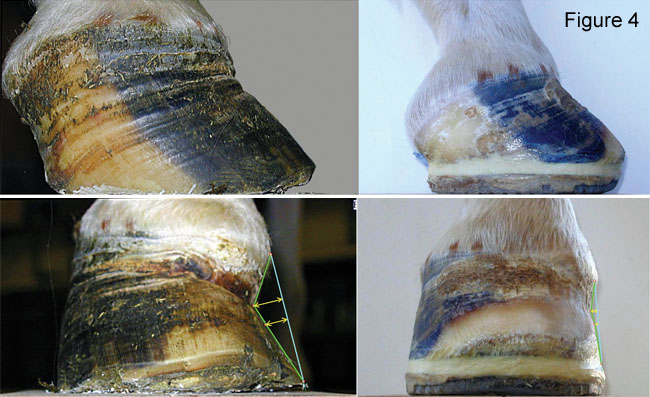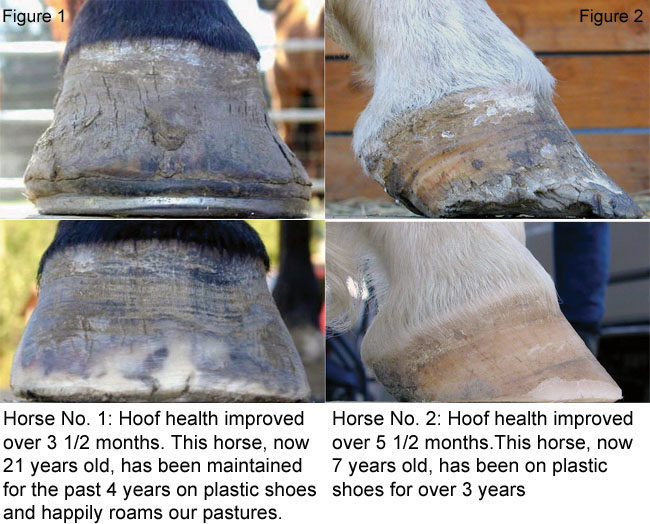Properly tapering the lap joint (scarfing) allows the edges of the materials to be properly blended during the welding process.
For the past 5 years, I have been applying plastic shoes to horses. These include “regular” horses, not just those with soundness issues. Over the past 4 years I’ve been involved (either directly or indirectly) with over 35 founder cases that have been treated using flexible shoes.
Why do I choose plastic over metal shoes? Because I want a prosthetic that is friendlier to the hoof’s function. Metal does not flex or absorb shock nearly as much as the natural hoof. The mechanical properties of metals (steel and aluminum) have little in common with those of hoof keratin (See Table 1). Flexible man-made synthetics like plastic come much closer.
Shoeing Choices
The three horses in the case studies presented here were initially shod with Marathon shoes (from Germany) and now with the EponaShoe.
I generally glue on the shoes rather than nail them because this leads to less hoof wall damage and because in some founder cases, there is no good wall to nail to. The glue spreads the load evenly and avoids concentrations at nail locations.
The EponaShoe provides good caudal support, which is important since in these cases loading of the hoof wall often needs to be minimized. I have chosen to write about these three particular horses because of the severity of the founder and because I have been able to follow their progress for a minimum of 2 years.
Case Studies
Two of the three horses ended up being part of our herd here at EponaTech Ranch. The other one went back to its home. All of these horses were referred by veterinarians and none were diagnosed with metabolic problems. I started treatment on these horses after acute founder episodes.

Horse No. 2: At the beginning of treatment (A), the angle was 14.4 degrees. This was reduced (B) to 8.1 degrees. Then, without proper follow-up and lack of motion (C), the angle again worsened to 12.6 degrees. Finally, under treatment again (D), the angle was lowered to 6.8 degrees. Today, this horse is being maintained at an angle of about 5.5 degrees. He has been ridden since 2004.
Although the use of plastic shoes is beneficial to the hoof, it is NOT a miracle cure for founder or any other serious hoof-related problems. The plastic shoe is a means to an end — its use enables me to eliminate some mechanical constraints placed on the hoof by the application of metal shoes. The key to any shoeing success rests in enabling proper function of internal hoof structures, trimming for a specific situation and using appropriate shoe placement.
Stimulating Growth
Plastic shoes allow added flexing of the hoof capsule, improving circulation, which in turn simulates new growth. I have data on over 400 horses in plastic shoes — the common denominator with all of them is improved horn quality and healthier horn growth. Trimming the hoof to help attain better joint alignment and giving arch and sole support will also contribute to improved circulation.
Under the right conditions, the hoof capsule can restructure itself very quickly. Some images of hoof resections I see in farrier and veterinarian magazines have me somewhat concerned.

Relationship between the hoof, synthetics, aluminum and steel. Values for hoof keratin are from1, and for other materials from2.
Is it truly necessary to resect hoof walls? Hoof wall resection is perhaps more often appropriate when using a metal shoe. With plastic shoes, it may not be done as routinely.
I believe that before doing radical horn removal, one should ask if there really is necrotic tissue that cannot be resolved by the animal on its own. The exact mechanism under which a hoof is able to restructure itself is poorly understood, but there is no doubt that the hoof is amazing in its capability to regenerate itself when allowed to do so (See Figures 1 and 2). The old-fashioned notion that the wall grows down from the corium seems not to be strictly true: there is some amount of new wall growth from within the hoof capsule3.
Deep resection can cause permanent change to molecular structure of the hoof keratin4. This means that the biochemical and biomechanical stability of the horn may become compromised. I suspect that any long term aggressive trimming of the horn will eventually cause loss of its mechanical integrity.
Tendons And Ligaments
It is also crucial to understand the mechanical properties of tendons and ligaments, especially how they react after immobilization. Tendons and ligaments will lose their flexibility if not put to work (See Figure 3.) It is harder to de-rotate the pedal bone of a foundered horse that does not get sufficient exercise. The tendons/ligaments tend to return to their atrophied state.
In the case of tendons, the muscles to which they attach are the real issue. It is these muscles that need to stretch and come back to some degree of normalcy. It has been shown in rehabilitative human medicine that after a tendon/ligament has been immobilized, the amount of time required to go back to its original elasticity is three times the length of time it was immobilized5. The foundered horse needs to be made comfortable as soon as possible in order for the horse to resume reasonably normal motion and exercise. It greatly helps the tendons and ligaments regain their flexibility.
I think that people misuse the term chronic founder. To me, a horse with chronic founder is one that continues to have laminitic episodes due to undiagnosed metabolic problems. Sometimes horses are called chronic because they have not been treated properly and keep returning to their old founder stance due to the lack of movement. We need to distinguish between metabolic issues and mechanical problems.
Most veterinary and farriery books present the correct joint alignment for the last three phalanges as a straight line. I have never felt this is quite right. The bones P3 (coffin joint), P2 (short pastern) and P1 (long pastern) are weight-bearing, and should align so that each bone is slightly more inclined than the one below it on the leg. That is, there should be a small rotation angle between phalanges, each a bit more up-right as we move up the phalanges6. I use software that I have developed, called Metron-PX, to assess the position of P3 within the hoof capsule and the alignment of the phalanges7.
Lowering Heels Vs. Raising Them
In many founder cases — including the three covered here — there has been a substantial rotation of the P3 bone. In such cases, a primary aim of my approach is, over time, to lower the heel to attempt to restore the angle of the P3 bone relative to ground.

Horse No. 3: Before (left) and after (right) photographs as severe founder is treated with plastic shoes. This horse, now 4 years old, has a lot of residual damage from the founder episode, but has been comfortable in plastic.
This process involves removing heel gradually, which is the opposite of some approaches that recommend the use of wedge pads to relieve stress on the deep digital flexor tendon. I feel that eventually we need to restore a more normal stance and we need to work against the tendency to atrophy. I also feel that with the heels elevated, a concentrated loading toward the toe occurs, which may contribute to the decalcification at the tip of P3 that occurs in some cases.
I try to bevel the shoe at the toe, and place it on the foot so as to minimize the “lever arm” and thus reduce DDFT forces (Figure 4). Using this method in conjunction with the plastic shoe and packing has made the horses comfortable almost immediately. It takes some attention to detail to change hoof angle by reasonable amounts over time for the process to succeed.
It is often the case that foundered horses kept on artificially high heels will eventually have to have tendon/ligament surgery to correct this problem. In human medicine, it is known that surgery to tendons and ligaments often has a side effect of irreversible damage to proprioceptors5 among other things. I believe the same is true for the horse, so — in my opinion — such tendon and ligament surgery should be used only as a last resort.
Packing The Hoof
Finally, I pack the bottom part of the hoof to allow the hoof to load evenly. The main complaint heard about packing is that it can make horses sore. That is true if people are not careful. Excessive sole removal — creating a big cup in the sole and then placing too much packing in it — can make the horse very sore. Preparing the sole carefully with only minor clean-up if needed, followed by selective use of packing and placement of packing, almost always succeeds.
Some thought is required before packing a hoof because of the varied shapes of pedal bones. It is important to choose the right material or materials to place under the sole. In difficult cases, I deal with problems like this by packing in multiple layers of material.

Horse No. 3: Before (left) and after (right) radiographs as severe founder is treated with plastic shoes. This horse, now 4 years old, has a lot of residual damage from the founder episode, but has been comfortable in plastic.
A layer of foam under the pedal bone does wonders in sore toe areas or when P3 has gone through the sole. In cases like these, I use a thicker layer of glue to lift the shoe off the sole. Judicious use of the glue will often allow you to work around hoof problems, such as abscesses. You can choose not to apply glue in some areas.
Conclusions
Due to the many variations and special situations that arise in the treatment of founder cases, it is unwise to promote a strict method to be followed. But adherence to some of the basic principles discussed in this article, in particular the use of a flexible shoe and a good means of frog/sole support, can help you achieve beneficial results. There are many other important aspects to trimming and shoeing for founder which could not be covered in this article.
In summary, flexible shoes make sense in treating founder cases for the following reasons:
- They absorb shock and make the horse more comfortable.
- A more comfortable horse moves more. This helps stop the further atrophy of muscles and tendons and helps speed rehabilitation.
- The plastic wears easier than metal, so the horse (or you) can adjust the various bevels (at the toe and also lateral-medial sides) as needed.
- The shoe does not inhibit flexing of the hoof and so aids in normal hoof function to pump blood, bringing nutrients to help rebuild damaged walls and reducing the need for resection.
- Since they are softer than any metal shoe, there is less chance of causing a hard pressure point to any region of the sole.
References
[1] Bertram J, Gosselin J, “Functional Design of Horse Hoof Keratin: The Modulation of Mechanical Properties through Hydration Effects,” Journal of Experimental Biology, 130, 121-136, 1987.
[2] Van Vlack L, Material Science for Engineers, Addison-Wesley, 1970.
[3] Bowker R, “The Growth and Adaptive Capabilities of the Hoof Wall and Sole: Functional Changes in Response to Stress,” in the proceedings of the 49th Annual Convention of the American Association of Equine Practitioners, New Orleans, 2003.
[4] Cope B, Hopegood L et al, “Studies of Equid Hoof Horn Material by EPR Spectroscopy,” Journal of Materials Chemistry, 8(1), 43-45, 1998.
[5] Martin R et al, Skeletal Tissue Mechanics, Springer Verlag, New York, 1998, Page 310.
[6] Craig J, Craig M, “Measuring the Hoof,” a presentation at the 2nd International Hoof Care Summit, Cincinnati, Ohio, January, 2005.








Post a comment
Report Abusive Comment